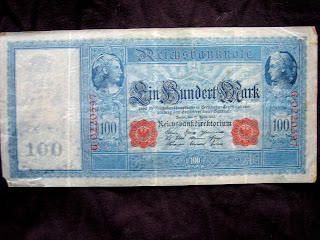
A couple of weeks ago, while my mother was out visiting the Pioneer Valley, we wandered into a local bookstore and picked up a nice copy of the first full-English translation of Robert Burton’s essential early modern pseudo-psychology treatise, The Anatomy of Melancholy (ed. Floyd Dell and Paul Jordan-Smith; New York: Tudor Publishing Company, 1938). I was intrigued by the book for academic reasons, but also because of a fascinating insert I noted as I flipped through it in the store.
When we got back home and started browsing through the book, we found several more of these peculiar inserts, apparently serving as bookmarks that had been long forgotten by some previous owner of the book (perhaps “Gladys L. Wheeler”, whose bookplate is inside the front cover; see below). Altogether, there were twelve colorful, well-preserved German bank notes in the book, spanning a period from 1908 through 1923. These important pieces of paper currency chronicle an extremely tumultuous and formative fifteen-year period in the history of the German nation, covering the transition from the imperial government (1874-1918) to the Weimar Republic (1918-1933) and the years before, during, and after World War I.
In chronological order, the Reichsbanknotes we found were the following:
100 marks: serial number 3684867H; Berlin, 7 February 1908 (10cm x 16cm)
100 marks: serial number G0220597; Berlin, 21 April 1910 (10cm x 20.5cm); two of these
1,000 marks: serial number 3256531K; Berlin, 21 April 1910 (11cm x 18.5cm)
50 marks: serial number 437438; Berlin, 24 June 1919 (10.25cm x 15.25cm)
10,000 marks: serial number U01369332; Berlin, 19 January 1922 (10cm x 18cm)
500 marks: serial number S8694405; Berlin, 7 July 1922 (9cm x 17.5cm)
50,000 marks: serial number 18N619250; Berlin, 19 November 1922 (11cm x 19cm)
5,000 marks: serial number K480537; Berlin, 2 December 1922 (9cm x 13cm)
20,000 marks: serial number 788021; Berlin, 20 February 1923 (9.5cm x 16cm)
2,000,000 marks: serial number 082710; Berlin, 23 July 1923 (8.75cm x 16.25cm)
In addition, there was a Darlehnskassenscheine note:
20 marks: serial number R7518630; Berlin, 20 February 1918 (9cm x 14cm)

Both bills measured their value in reichsmarks (or simply “marks”), though slightly differently. The reichsbanknotes were issued by the central government (first the Imperial Treasury and then, in the Weimar period, the state bank) and carried their value first with gold-backing and then (after Germany left the gold standard) with a pledge of the full faith and backing of the state.The darlehnskassenscheine notes were issued by the state loan offices (only between 1914 and 1918) and were covered by industrial and agricultural goods, rather than bullion; they were, in effect, liquid “cash” borrowed against the material collateral of the nation and useful for paying the immediate costs of the war. Those of you who are really interested in the dirty details of early twentieth-century German monetary policy can find additional information in chapter eight of Elisha Friedman’s International Finance and Its Reorganization (published in 1922, Friedman’s book provides a contemporary, rather than historical, account of Germany’s fiscal woes).

I’m not a numismatist, so my research on these bills has been fairly haphazard. The years prior to the outbreak of World War I saw German monetary policy and value relatively stable; however, with the outbreak of the war, the government soon abandoned the gold standard for its currency and quickly began producing paper bills to meet its extraordinary wartime costs. The result was massive, crippling inflation and the disappearance altogether of coins from the German currency system in the 1910s and 1920s. At the end of 1923, the newly-appointed National Currency Commissioner Horace Schacht instituted a reform program that replaced the worthless reichsmark with the new rentenmark (the value of 1 rentenmark was set at 1 trillion reichsmarks)

Not only were many of these bills worthless then, but even today there are so many out on the market that, as collector’s items, they are generally inexpensive. Rather than think of them as collectible investments, then, I prefer to admire their exquisite art-deco and early twentieth century artwork, the craftsmanship of the printing and paper design (some terrific watermarks [above and right], vibrant inks, and anti-counterfeiting colored threads), the elaborate and almost dynamic teutonic fonts, and, of course, their unique and ultimately unrecoverable relationship to my 1938 edition of The Anatomy of Melancholy.






















i got one more from the 1,000 marks: serial number c.4348749; Berlin, 21 April 1910 (11cm x 18.5cm)
ReplyDeleteredxlled@gmail.com
if anyone is interested
Good reading thanks - Ive come accross half dozen 20 marks as well as one 10,000 mark different from yours 19 Jan 1922 rather stern looking gent on the front lovely green & blue on the back.
ReplyDeleteMany thanks for all the info, my kids thought they'd struck it rich when I showed them. I got them in africa 30 years ago